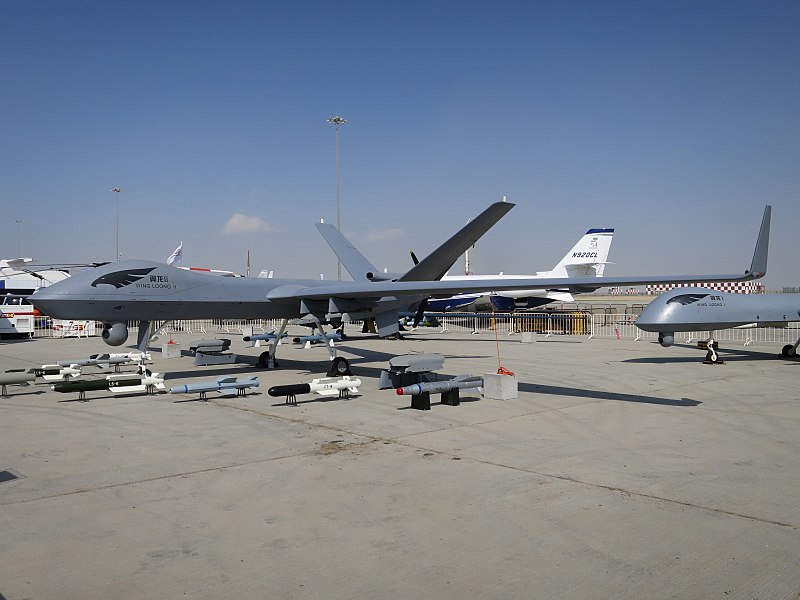
It’s always only a matter of time before countries explore each other’s successes (or failures) and this is no different. Combat drones, powered by advanced technology like artificial intelligence, are the new ‘wingmen’ to Chinese carrier-based fighter jets. Essentially, it appears to be an attempt to compete with the prowess of the United States’ unmanned aerial vehicle (UAV) programs. Some believe that it’s China’s version of the US Navy’s Unmanned Carrier Launched Airborne Surveillance and Strike (UCLASS).
According to Shi Wen, chief engineer and designer of China’s Caihong (CH), or Rainbow UAV series, “The joint operations of manned military aircraft, like fighter jets, and UAVs is the drone’s future. We are making efforts to promote artificial intelligence (AI) for UAVs to allow manned aircraft to co-pilot UAVs.”
Killer Combat Drones and Artificial Intelligence
Under the China Aerospace Science and Technology Corp (CASC), Shi and his team have developed a series of combat drones. These include the CH-3, CH-4 and the advanced CH-5, which can engage in reconnaissance and attack missions. These combat drones are popular among nations along the Belt and Road initiative, especially the Middle East and Africa. Countries in these regions generally have a much larger demand for weapons.
The media shares mixed reports about the specifications of these UAV’s but here’s the general consensus. A 330 horsepower heavy fuel engine powers the CH-5 which increases endurance and range by 20-30%. This translates to 60 hours flight time covering 10 000 km while flying at 30 000 ft (7 000 m).
Heavy fuel engines power most Western-made combat drones and the CH-5 is no different. This heavy fuel is denser and contains more energy than regular gasoline, which results in improved endurance and range.
The CH-5 reportedly has a wingspan of 21 meters with a payload of up to 1 200 kilograms. This is 2.6 times more than previous combat UAV’s in the CH series. The payload capacity allows for up to 16 air-to-ground weapons. This includes laser-guided air-to-surface missiles, laser/INS/GPS-guided bombs and anti-tank missiles. Some believe that the CH-5 capabilities are inferior to General Atomics’ MQ-9 Reaper; either way, it’s still a formidable aircraft.
The Race For Aerial Supremacy Is On
China is in the process of building a powerful navy. Their first domestically built aircraft carrier is preparing for its first sea trial. According to Li Jie, a naval expert from Beijing, “Although the military has not released any information, research into carrier-based UAVs started long ago, and ship-based UAVs on destroyers and frigates have already been used in training.”
Read the full article here – Government support needed for carrier-based UAVs to build powerful navy.
Speaking of developments in artificial intelligence and UAV’s, Director at the Center for a New American Security, Paul Scharre, had this to say.
“When it comes to technology, the Chinese military are very aggressive in experiments of how they want to use it. It’s not surprising to see [China] lean into this and I wouldn’t be surprised to see them actually doing some of the implementation sooner than some Western countries.”
China’s military is already in the process of launching a more advanced drone than the already impressive CH-5. All eyes are on the 2018 Airshow China in Zhuhai later this year where the CH-X will be displayed.
Drone Technology Applications
Many companies from China, America and Europe are major competitors in the UAV and artificial intelligence market. Although focus always seems to be on military applications, UAV’s are important for civilian uses as well. In fact, the civilian uses of UAVs are a larger share than military applications.
Forest and wildlife protection, exploration of underground resources and monitoring oceans are ideal for the CH series UAV. Other types of drones are prominent in agriculture, aquaculture, real estate development, aerial photography and emergency response.
What are your thoughts on the rapid development of artificial intelligence, not just with UAV’s, but other areas as well? Do you think that combat drones as ‘wingmen’ for fighter jets is a good idea? We’d love to hear from you in the comments section below or find us on Twitter, Facebook, Google+ or LinkedIn using #PRVTech.
Contact us via the website if you have any questions about PRV Engineering and how we can help with your manufacturing and engineering project.
One comment
Leave a Comments Cancel Reply
This site uses Akismet to reduce spam. Learn how your comment data is processed.


 Mail:
Mail: 




[…] Related: ‘AI Combat Drones: New Wingman For Fighter Jets’ […]